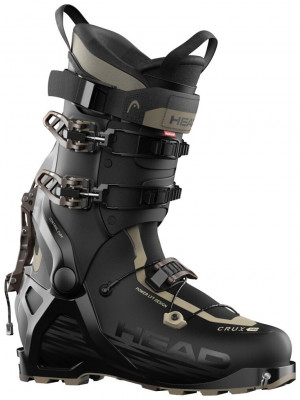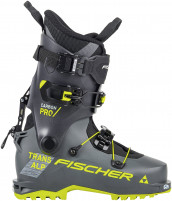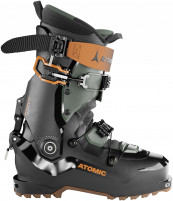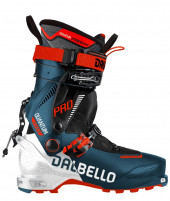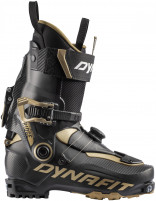HEAD Crux Pro Boot
The HEAD Crux Pro Boot might be having a bit of an identity crisis. Two buckles and a power strap on a stiff and supportive upper cuff are reminiscent of an alpine boot, but the tongueless construction and wave closure on the lower sit firmly in highly efficient touring boot territory. Drawing inspiration from various corners of the ski boot world, it's a very intentional design choice by HEAD, and the result is a boot that combines strong downhill performance with remarkable tourability. The LYT* Dynamic Frame provides power transmission throughout the entire boot with reinforced connections between the lower shell, cuff, and ski/walk mechanism. Flipping the walk lever upwards unlocks an ample range of motion for easy skinning while the wave closure keeps your foot seated firmly in the lower. HEAD has utilized Pebax Rnew in the boot's shell, a light and strong bio-plastic sourced from castor seeds that retain its physical properties throughout a wide range of temperatures, for a product that is both eco-conscious and resilient to the harsh weather you may encounter on your adventures. A Vibram Durastep outsole keeps your feet firmly planted when you're booting or crossing a treacherously slick parking lot. The Crux Pro is a precise downhill tool that also provides an excellent experience on the skin track as well.
- Alpine-like cuff with a cam-lock power strap provides excellent downhill power.
- LYT Dynamic Frame throughout the boot gives a direct and precise feel.
- Moldable liner with reinforced tongue and upper cuff for additional stiffness.
- Pebax Rnew and recycled carbon fibers used in the boot are light, strong, and eco-friendly.
- Vibram Durastep outsole prevents unintentional slippage.
- RECCO rescue reflectors provide an additional level of discoverability in an avalanche.
* We presume LYT should be pronounced "Light", but could alternatively stand for "Lean Y-Bracket Technology", "Lil Yachty Tugboat", or any number of things.
| Specifications | |
|
Weight |
1357g [27.5] |
| Weight (pair) | 2714g [27.5] |
|
|
3 + 40mm Ratchet Power Strap |
|
Boot Sole |
281mm [25/25.5] 291mm [26/26.5] 301mm [27/27.5] 311mm [28/28.5] 321mm [29.29.5] |
|
Binding |
Tech only |
|
Cuff |
55° |
|
Forward |
12°, 14°, 16° |
| Specs Verified | Yes |
| Design | |
|
|
Pebax Rnew + Recycled Carbon Fibers |
|
|
Crux Pro HP |
|
|
Vibram Durastep |
| Skimo Co Says | |
| Usage | (Free)Touring |
| Notes | Alpine upper cuff meets touring lower shell |
| Bottom Line | Boot of one contender |
| Compare to other Touring Boots | |
Related Products
Questions & Reviews
Following up on Ben's question about the internal length of the shell, how do these compare to the 24/25 Hawx Ultra XTD 130 Boa and original Tecnica ZGTP? I ski the Hawx in a 26.5 with a race fit--I haven't punched the toes yet but likely will to get just a little more space. I trying to figure out if I can make a Crux 26.5 work for touring with some punches.
In line with their low-volume nature, these boots do a great job of securing narrow calves and lower legs. If you found success in the TLT5 and Hawx Ultra 130, I think you'll likely find the same in the Crux.
Regarding length, these are accurate to their respective mondo size. Punching out the toe is tricky, however, so it may be best to fill out our Boot Fitter, and we can discuss the specifics. Thanks!
Good question! I just checked, and indeed it will work with the TR1!
Cosmos Pro?
I would consider this more of an LV boot, with a higher instep. It is pretty narrow with a stated last of 97mm, which tracks with LV shells. The instep isn't super low. However, it is overall a narrower fit, and it's definitely not high volume.
The liners are of medium thickness - more substantial than the liners in most lightweight boots, but not super thick, as the shell does fit pretty tight. I would guess around 9mm thickness. Unfortunately, I cannot compare directly to the Cosmos as we don't carry that boot, so I don't have one to check - but in general, this is a lighter boot than the Cosmos and may not be as warm.
Thanks
The high cuff and reasonable stiffness are very compelling for my excessively dorsiflexy ankles and disproportionately long and bony fibias, which tend to crush through the flex of lighter boots and cause my shins to bleed.
I'm also after the absolute lowest volume heel pocket around to fit my average width forefoot but super low volume feet, ankles, calves.
Could this be the boot for me? Are there any other touring boots that can securely lock down bony, hypermobile heel?
This boot could be a pretty good option for you! It is certainly narrow and snug around the heel, ankle, and navicular areas. The forefoot opens up a little bit, but is still on the narrower side. With the right footbed, I think you might be able to make it work. And it is very stiff for this category of boot!
In general, touring boots are not the best at completely locking down your heel like an alpine boot. This is because that level of heel hold would be very uncomfortable while walking and would cause blisters when your heel inevitably started to move around a little bit. But this is one of the more snug heel cups I've tried in a touring boot! Another boot with a similarly snug fit around the heel and ankle, but more room in the forefoot than the Crux, is the La Sportiva Skorpius.
Thanks for the prompt, detailed reply! Sounds like the Skorpius could also be worth a try (in a lighter, less downhill-oriented package, yes?). How does the Tecnica Zero G Tour Pro compare to these two?
Would there be any benefit to be had fit-wise by moving to a much heavier boot in something like an Atomic Hawx Ultra XTD? I know that this is not really a touring boot as such, but wonder if that may be a compromise worth making?
Thank you and all the best,
H
Does this mean that less heel hold is actually better when it comes to blisters? I assume too little hold is a bad thing so are we just trying to find a happy medium? I struggle with blisters while touring and I always assumed I needed to lock my heel down as much as possible...
That is a common misconception about heel hold and blisters! I'll start by saying that it is certainly possible to have excessive heel movement that leads to blistering. This usually happens because someone is in the wrong size shell, or in a shell that is too high-volume, and not because the heel itself is too loose. For people who are in the right size boot, we often find that heel blistering is actually caused by heel cups that are too tight, which can be resolved by punching them out slightly!
If you start from the assumption that the foot is always going to move a little bit inside the boot while walking (which it always will, unless you lock it down with uncomfortable amounts of pressure), it then follows that to prevent blisters, you need to allow the foot to move an acceptable amount without creating excessive friction in any one spot. This means not having a heel cup that is clamped super firmly onto your heel - if it is, and your foot moves at all, you will blister super quickly. Vise-like heel hold is good for downhill performance, but would not be comfortable on the uphill.
The usual blister checklist is 1) do you have the right size boot? 2) do you have the appropriate amount of volume in the boot? 3) have you added a good footbed? 4) are you wearing thin, tight-fitting ski socks to reduce friction as much as possible? If you check all of those boxes and are still having issues, it's likely that something about the heel cup isn't working for you, and much of the time, it's that the heel cup is too tight in a certain spot. A liner mold and shell work are the next steps.
The Head Crux Pro is stiffer than the Transalp, although potentially a little bit less progressive. Sizing-wise, they are a very similar length in the 28/28.5 mondo size. The fit is a little bit different though - primarily, the Head boot is narrower overall, and especially in the heel and midfoot. The Fischer is more of a medium fit, with a more accommodating ankle and heel.
I think the Crux Pro is a bit stiffer than both of those boots, although not as progressive as the Transalp Pro. It is a powerful boot, but not the most progressive (although better than other, lighter weight tongueless boots). The fit is narrower and a bit lower vertically than the Backland XTD.
Sincerely,
- wide forefoot but otherwise low volume foot gang
And it's not a freeride boot, it is an impossible beef boot ;) Thanks!
I think the Backland XTD walks slightly better, but it is close! They are both quite good.
Earn store credit by writing reviews. Learn more.





